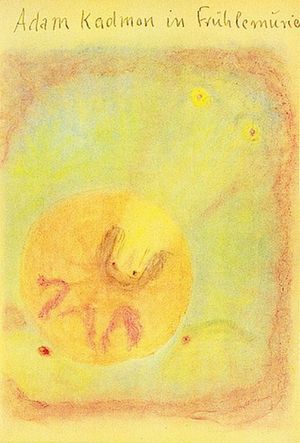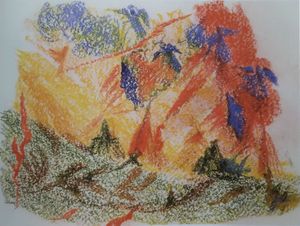Lemuria


The Lemurian period, also called the third root race[1] according to obsolete theosophical tradition, is the third of the seven main ages into which the present physical state of form of the Earth is divided[2]. It followed the Hyperborean period in which the Earth and the Sun separated from each other. According to a statement by Rudolf Steiner, which is, however, only poorly documented, the Lemurian period corresponds approximately on the geologic time scale to the Mesozoic era (Lit.:GA 300a, p. 107), which according to the results of external research began about 252.2 million years ago and ended about 66 million years ago. In fact, the earliest Lemurian may already have begun with the start of the Proterozoic, about 2,500 million years ago[3]. All time references here are for comparison only and are to be taken with great caution, as Rudolf Steiner also clearly points out.[4] After the Lemurian period, the Atlantic era began.
Lemuria
The name Lemuria was coined in 1858 by the geologist Philip Sclater, based on the former land bridge between South Africa and India postulated earlier by Ernst Haeckel, Melchior Neumayr and other geologists to explain the strange distribution of lemurs living only in Madagascar and the Near East. H. P. Blavatsky adopted this designation in her theosophical writings. With the theory of continental drift developed by Alfred Wegener (1880-1930) and the modern theory of plate tectonics based on it, the original thesis of a primeval land bridge between Africa and Asia was rejected.
Rudolf Steiner, however, confirmed from his spiritual research the existence of ancient Lemuria, which in his view actually extended in the area between Africa, Asia and Australia - but not in the sense of the outdated land bridge theory. It was that continental area where man developed during the Lemurian period. Lemuria perished due to earthquake and volcanic catastrophes.
Literature
- William Elliot-Scott: The Lost Lemuria, The Theosophical Publishing House, Ltd., London 1904 pdf
- Walther Cloos: Lebensstufen der Erde. Beiträge zu einer organischen Gesteins- und Mineralkunde, Verlag Freies Geistesleben, Stuttgart 1984 ISBN 978-3772504853
- Wolfhard Wimmenauer: Zwischen Feuer und Wasser: Gestalten und Prozesse im Mineralbereich, Urachhaus Verlag, Stuttgart 1992 ISBN 978-3878389453
- Dankmar Bosse: Die gemeinsame Evolution von Erde und Mensch: Entwurf einer Geologie und Paläontologie der lebendigen Erde, Verlag Freies Geistesleben, Stuttgat 2002, ISBN 978-3772515934
- Dankmar Bosse: Die Lebenssphäre der Erde: Ihre Evolution in den geologischen Phänomenen, Rudolf Steiners Forschungen und in Goethes Studien, Verlag Freies Geistesleben, Stuttgart 2012. ISBN 978-3905919370
- Andreas Delor: Atlantis nach neuesten hellsichtigen und wissenschaftlichen Quellen: Band 6; Lemurien I; Feuerkatastrophen, Inkarnation der Urvölker, Kain und Abel, Christian Möllmann Verlag, 2014, ISBN 978-3899792157
- Andreas Delor: Atlantis nach neuesten wissenschaftlichen und hellsichtigen Quellen: Band 7 Lemurien II Zwischen Sonnentrennung und Mondentrennung, Christian Möllmann Verlag, 2015, ISBN 978-3899792348
- Rudolf Steiner: Aus der Akasha-Chronik, GA 11 (1973), Kapitel Die lemurische Rasse English: rsarchive.org German: pdf pdf(2) html mobi epub archive.org
- Rudolf Steiner: Die Geheimwissenschaft im Umriß, GA 13 (1968), Kapitel Die Weltentwickelung und der Mensch English: rsarchive.org German: pdf pdf(2) html mobi epub archive.org
- Rudolf Steiner: Kosmogonie, GA 94 (2001), ISBN 3-7274-0940-1 English: rsarchive.org German: pdf pdf(2) html mobi epub archive.org
- Rudolf Steiner: Ägyptische Mythen und Mysterien, GA 106 (1992), ISBN 3-7274-1060-4 English: rsarchive.org German: pdf pdf(2) html mobi epub archive.org
- Rudolf Steiner: Mysterienwahrheiten und Weihnachtsimpulse. Alte Mythen und ihre Bedeutung, GA 180 (1980), ISBN 3-7274-1800-1 English: rsarchive.org German: pdf pdf(2) html mobi epub archive.org
- Rudolf Steiner: Konferenzen mit den Lehrern der Freien Waldorfschule 1919 bis 1924, GA 300 a-c (1995), ISBN 3-7274-3000-1 English: rsarchive.org German: pdf pdf(2) html mobi epub archive.org
- Rudolf Steiner: Die vierte Dimension, GA 324a (1995), ISBN 3-7274-3245-4 English: rsarchive.org German: pdf pdf(2) html mobi epub archive.org
 |
References to the work of Rudolf Steiner follow Rudolf Steiner's Collected Works (CW or GA), Rudolf Steiner Verlag, Dornach/Switzerland, unless otherwise stated.
Email: verlag@steinerverlag.com URL: www.steinerverlag.com. Index to the Complete Works of Rudolf Steiner - Aelzina Books A complete list by Volume Number and a full list of known English translations you may also find at Rudolf Steiner's Collected Works Rudolf Steiner Archive - The largest online collection of Rudolf Steiner's books, lectures and articles in English. Rudolf Steiner Audio - Recorded and Read by Dale Brunsvold steinerbooks.org - Anthroposophic Press Inc. (USA) Rudolf Steiner Handbook - Christian Karl's proven standard work for orientation in Rudolf Steiner's Collected Works for free download as PDF. |
References
- ↑ The term root race derives from the terminology used at that time by the Theosophical Society and was later no longer used by Rudolf Steiner, as was the term subrace. Steiner repeatedly pointed out that the term "race" is actually no longer justified in the post-Atlantean time, since now it is no longer the physical but the soul-spiritual development that comes to the fore. The division of humanity into races will gradually be completely overcome and is already meaningless for the spiritual development of man.
- ↑ The actual Earth evolution begins in the fourth and middle of the seven so-called rounds or life stages, during which the Earth existence unfolds. In the first three rounds, earlier states of embodiment of the earth were repeated in an abbreviated form in order to make the fruits of these earlier forms of existence ripe for the actual earth development. The actual Earth evolution, the fourth round, will be followed by three more rounds in which future new embodiments of the Earth will be anticipated in a certain sense. Each state of life is in turn divided into seven form states, the fourth and middle of which is the physical form state in which the physical Earth evolution takes place.
- ↑ cf. the table in Bosse 2002, p. 57
- ↑
„In geology we describe one period after another, as if it were a reality. It is not. It is only a reality with the whole of the Earth, in the same way that an organism is a reality, where I must not tear out one thing. Instead of relating our processes to coordinate axis systems, it would be more important to relate them to their own inner reality, then we would arrive at totality systems. And then we would have to come back to a kind of monadism.“ (Lit.:GA 324a, p. 144)
